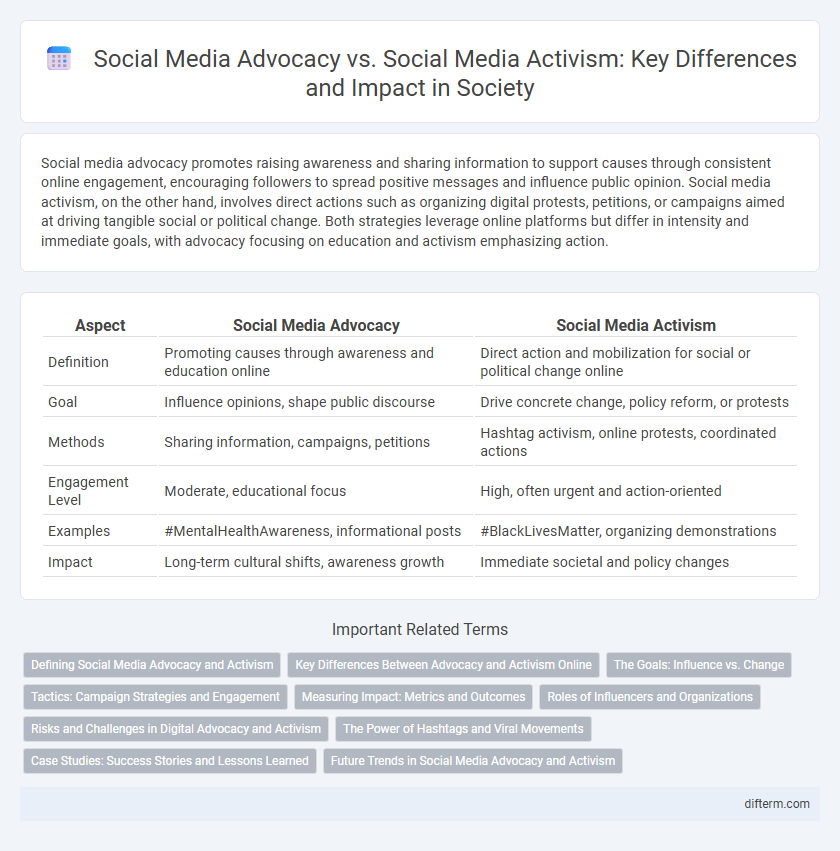Social media advocacy promotes raising awareness and sharing information to support causes through consistent online engagement, encouraging followers to spread positive messages and influence public opinion. Social media activism, on the other hand, involves direct actions such as organizing digital protests, petitions, or campaigns aimed at driving tangible social or political change. Both strategies leverage online platforms but differ in intensity and immediate goals, with advocacy focusing on education and activism emphasizing action.
Table of Comparison
| Aspect | Social Media Advocacy | Social Media Activism |
|---|---|---|
| Definition | Promoting causes through awareness and education online | Direct action and mobilization for social or political change online |
| Goal | Influence opinions, shape public discourse | Drive concrete change, policy reform, or protests |
| Methods | Sharing information, campaigns, petitions | Hashtag activism, online protests, coordinated actions |
| Engagement Level | Moderate, educational focus | High, often urgent and action-oriented |
| Examples | #MentalHealthAwareness, informational posts | #BlackLivesMatter, organizing demonstrations |
| Impact | Long-term cultural shifts, awareness growth | Immediate societal and policy changes |
Defining Social Media Advocacy and Activism
Social media advocacy involves the strategic promotion of specific causes or policies through targeted content aimed at influencing decision-makers and raising awareness. Social media activism encompasses a broader, grassroots-driven engagement where users mobilize online communities to support social or political movements, often emphasizing real-time participation and collective action. Both use digital platforms but differ in scope, intent, and methods of engagement within social justice and policy change frameworks.
Key Differences Between Advocacy and Activism Online
Social media advocacy centers on promoting specific causes through awareness campaigns, content sharing, and influencing public opinion, often using strategic messaging to engage followers. Social media activism involves direct actions such as organizing protests, digital sit-ins, or hashtag campaigns aimed at creating tangible social or political change. Unlike advocacy's emphasis on education and persuasion, activism prioritizes urgent mobilization and collective action through online platforms.
The Goals: Influence vs. Change
Social media advocacy aims to influence public opinion and policy by raising awareness and encouraging dialogue within existing frameworks. Social media activism seeks to drive substantial social or political change by mobilizing communities and challenging systemic issues. Both approaches utilize digital platforms, but advocacy prioritizes shaping perceptions while activism focuses on transformative action.
Tactics: Campaign Strategies and Engagement
Social media advocacy employs targeted campaign strategies such as influencer partnerships and hashtag initiatives to build awareness and drive gradual policy change. Social media activism leverages real-time engagement tactics including live streaming protests, coordinated digital sit-ins, and viral content to mobilize immediate grassroots action and public pressure. Effective campaigns blend both approaches by aligning sustained advocacy messaging with dynamic activist participation to maximize visibility and impact.
Measuring Impact: Metrics and Outcomes
Social media advocacy measures success through engagement rates, follower growth, and sentiment analysis to evaluate awareness and long-term support. Social media activism emphasizes direct action metrics such as petition signatures, event attendance, and policy changes influenced by online campaigns. Both approaches use data analytics to assess reach and effectiveness, but activism prioritizes tangible social or political outcomes over general visibility.
Roles of Influencers and Organizations
Influencers on social media leverage their personal brand to endorse causes, raising awareness and shaping public opinion through authentic engagement. Organizations utilize structured campaigns and data-driven strategies to mobilize communities, drive policy change, and sustain long-term social impact. The collaboration between influencers and organizations enhances message reach and effectiveness, blending personal trust with strategic advocacy.
Risks and Challenges in Digital Advocacy and Activism
Social media advocacy faces risks such as misinformation, digital harassment, and platform algorithm biases that can hinder message reach and engagement. Social media activism encounters challenges including surveillance by authorities, online censorship, and the potential for slacktivism, which may dilute real-world impact. Both forms require strategic navigation of privacy concerns and the evolving dynamics of digital platforms to maintain credibility and effectiveness.
The Power of Hashtags and Viral Movements
Hashtags serve as powerful tools in social media advocacy by amplifying messages and fostering community engagement around specific causes, enabling advocates to reach broader audiences efficiently. Viral movements leverage these hashtags to create rapid, widespread awareness, often sparking offline actions and influencing public opinion. The strategic use of hashtags transforms isolated posts into collective calls for change, harnessing digital momentum to drive social impact.
Case Studies: Success Stories and Lessons Learned
Social media advocacy leverages targeted campaigns like the ALS Ice Bucket Challenge, which raised over $115 million for ALS research by encouraging widespread participation and donations. Social media activism, exemplified by the #BlackLivesMatter movement, drives systemic change by mobilizing global protests and influencing policy discussions through real-time storytelling and community engagement. Key lessons include the importance of clear messaging, sustained engagement, and combining online efforts with offline actions to maximize impact.
Future Trends in Social Media Advocacy and Activism
Social media advocacy is evolving with advancements in AI-driven analytics that enable more targeted campaigns and personalized engagement, enhancing message resonance and impact. The rise of decentralized platforms and blockchain technology is expected to increase transparency and trust in activism efforts, empowering users to verify information and reduce misinformation. Emerging trends also highlight the integration of augmented reality (AR) experiences to create immersive advocacy that drives higher emotional connection and real-world action.
social media advocacy vs social media activism Infographic

 difterm.com
difterm.com